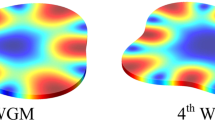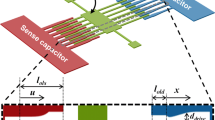Abstract
A variable attenuator is one of the essential components in radio frequency (RF) systems, such as automatic gain control amplifiers and full-duplex systems. Variable attenuators based on microelectromechanical systems (MEMS) technology have several advantages over the semiconductor counterparts, including low power consumption and suppressed harmonics. Attenuation can be realized by disruption of signal propagation, which is induced by moving electrodes placed next to a signal line. In this work, the effect of the moving electrodes on the RF characteristics of the variable attenuators is studied via numerical simulation. It is observed that 10 \(\upmu\)m of moving electrode displacement can result in 18 dB of attenuation dynamic range at 20 GHz. The similar type of RF MEMS variable attenuators reported previously showed substantial nonlinearity in attenuation-voltage characteristics, which becomes a serious drawback for applications where high-precision attenuation management is required. The main objective of the current study is, therefore, to achieve high dB-linearity, by employing shaped-finger comb-drive actuators in the moving electrode displacement control. In addition, a nonlinear relationship between force and displacement in a clamped-clamped beam spring is taken into account for more accurate device modelling. Through finite element analysis, it is shown that an improvement by a factor of twelve can be obtained in dB-linearity by using a single-comb shaped-finger actuator, compared to standard straight-finger comb-drives. The study also shows that the dB-linearity can be further (2.2 times additionally) improved by utilizing dual-comb shaped-finger actuators.





Similar content being viewed by others
Abbreviations
- A :
-
Attenuation, equals to \(-S_{21}\)
- \(C_{bias}\) :
-
Unit 2-D capacitance, bias comb
- \(c_{dblin}\) :
-
Coefficient of dB-linearity
- \(C_{DRIVE}\) :
-
Unit 3-D capacitance, drive comb
- \(C_{drive}\) :
-
Unit 2-D capacitance, drive comb
- \(d_{bias}\) :
-
Finger gap profile, bias comb
- \(d_{drive}\) :
-
Finger gap profile, drive comb
- E :
-
Young’s modulus
- \(F_{elec}\) :
-
Electrostatic force
- \(F_{mech}\) :
-
Mechanical restoring force
- \(g_{me}\) :
-
Gap between a moving electrode and a signal line
- \(k_1\) :
-
Spring constant, linear term
- \(k_3\) :
-
Spring constant, cubic term
- \(l_{ol}\) :
-
As-fabricated overlap length between fingers
- \(S_{11}\) :
-
Reflected power at port 1, return loss
- \(S_{21}\) :
-
Power transferred from port 1 to port 2, insertion loss
- u :
-
Distance from the moving finger tip, drive comb
- V :
-
Applied voltage, drive comb
- v :
-
Distance from the moving finger tip, bias comb
- \(V_{bias}\) :
-
Applied bias voltage, bias comb
- x :
-
Beam center (moving electrode) displacement
- \(x_{i}\) :
-
Excluded zone length
- \(x_{fex}\) :
-
Far-side extension length
- \(x_{max}\) :
-
Maximum displacement range
- \(x_{nex}\) :
-
Near-side extension length
References
Borovic B, Lewis F, Liu A et al (2006) The lateral instability problem in electrostatic comb drive actuators: modeling and feedback control. J Micro mech Microeng 16(7):1233. https://doi.org/10.1088/0960-1317/16/7/017
Casals-Terre J, Fargas-Marques A, Shkel AM (2008) Snap-action bistable micromechanisms actuated by nonlinear resonance. J microelectromech syst 17(5):1082–1093. https://doi.org/10.1109/JMEMS.2008.2003054
Chang S, Sivoththaman S (2006) A tunable rf mems inductor on silicon incorporating an amorphous silicon bimorph in a low-temperature process. IEEE Elect Device Lett 27(11):905–907. https://doi.org/10.1109/LED.2006.884712
Da Rezaei H, Kadkhodaei M, Nahvi H (2012) Analysis of nonlinear free vibration and damping of a clamped-clamped beam with embedded prestrained shape memory alloy wires. J Intel Mater Syst Struct 23(10):1107–1117. https://doi.org/10.1177/1045389X12441509
Destino G, Kursu O, Tammelin S, et al (2017) System analysis and design of mmw mobile backhaul transceiver at 28 ghz. 2017 European Conference on Networks and Communications (EuCNC)
Engelen JBC, Abelmann L, Elwenspoek MC (2010) Optimized comb-drive finger shape for shock-resistant actuation. J Micro mech Microeng 20(105):003. https://doi.org/10.1088/0960-1317/20/10/105003
Gao H, Wang W, Fan W et al (2021) Design and experimental validation of automated millimeter-wave phased array antenna-in-package (aip) experimental platform. IEEE Trans Instrument Meas 70:1–11. https://doi.org/10.1109/TIM.2020.3024428
Habbachi N, Besbes K (2022) Rf mems filter based on dual liquid variations. J Micromech Microeng 32(6):065002. https://doi.org/10.1088/1361-6439/ac6203
Hah D (2017) A design method of comb-drive actuators for linear tuning characteristics in mechanically tunable optical filters. Microsyst Technol 23:3835–3842. https://doi.org/10.1007/s00542-015-2736-8
Hah D (2020) Linear variable optical attenuators with shaped-finger comb-drive actuators. Appl Opt 59:277–284. https://doi.org/10.1364/AO.59.000277
Hah D (2022) Analytical design of mems variable capacitors based on shaped-finger comb-drives. Microsyst Technol 28(6):1423–1434. https://doi.org/10.1007/s00542-019-04362-x
Hajati A, Kim SG (2011) Ultra-wide bandwidth piezoelectric energy harvesting. Appl Phys Lett 99(8):083–105. https://doi.org/10.1063/1.3629551
Huang W, Lu G (2004) Analysis of lateral instability of in-plane comb drive mems actuators based on a two-dimensional model. Sens Actuat A: Phys 113(1):78–85. https://doi.org/10.1016/j.sna.2003.12.032
Huang YY, Woo W, Yoon Y et al (2011) Highly linear rf cmos variable attenuators with adaptive body biasing. IEEE J Solid-State Circuit 46(5):1023–1033. https://doi.org/10.1109/JSSC.2011.2117530
Iannacci J, Tagliapietra G (2022) Getting ready for beyond-5g, super-iot and 6g at hardware passive components level: a multi-state rf-mems monolithic step attenuator analyzed up to 60 ghz. Microsyst Technol 28:1235–1240. https://doi.org/10.1007/s00542-022-05285-w
Jensen B, Mutlu S, Miller S et al (2003) Shaped comb fingers for tailored electromechanical restoring force. J Microelectromech Syst 12(3):373–383. https://doi.org/10.1109/JMEMS.2003.809948
Johnson W, Warne L (1995) Electrophysics of micromechanical comb actuators. J Microelectromech Syst 4:49–59. https://doi.org/10.1109/84.365370
Khaira NK, Singh T, Mansour RR (2019) Monolithically integrated rf mems-based variable attenuator for millimeter-wave applications. IEEE Transact Microwave Theory Tech 67(8):3251–3259. https://doi.org/10.1109/TMTT.2019.2925798
Kolodziej KE, McMichael JG, Perry BT (2016) Multitap rf canceller for in-band full-duplex wireless communications. IEEE Transact Wireless Commun 15(6):4321–4334. https://doi.org/10.1109/TWC.2016.2539169
Kumar D, Siju V, Pathak SK (2019) Design of rf agc scheme for improving dynamic range of multichannel heterodyne ece radiometer in sst-1 tokamak. Fusion Eng Design 142:80–84. https://doi.org/10.1016/j.fusengdes.2016.05.007
Lee KB, Lin L, Cho YH (2008) A closed-form approach for frequency tunable comb resonators with curved finger contour. Sens Atuators A: Phys 141(2):523–529. https://doi.org/10.1016/j.sna.2007.10.004
Levinger R, Yishay RB, Katz O et al (2016) High-performance e-band transceiver chipset for point-to-point communication in sige bicmos technology. IEEE Trans Micro Theory Tech 64(4):1078–1087. https://doi.org/10.1109/TMTT.2016.2528981
Rezaei DA, Kadkhodaei M, Nahvi H (2012) Analysis of nonlinear free vibration and damping of a clamped-clamped beam with embedded prestrained shape memory alloy wires. J Intel Mater Syst Struct 23(10):1107–1117. https://doi.org/10.1177/1045389X12441509
Saleh H, Shojaeian M, Bajwa R et al (2022) Low actuation voltage cantilever-type rf-mems shunt switches for 5g applications. Microelect Reliab 136(114):645. https://doi.org/10.1016/j.microrel.2022.114645
Sharaf A, Nasr A, Elshurafa AM et al (2022) Design analysis and simulation of a digital rf mems varactor with high capacitive ratio. Microsys Technol 28:1831–1844. https://doi.org/10.1007/s00542-022-05318-45
Sravani KG, Guha K, Aditya M et al (2022) Design, simulation and analysis of uniform and non-uniform serpentine step structure rf mems switch. Microsys Technol 28:855–865. https://doi.org/10.1007/s00542-021-05216-1
Sun KO, Choi MK, van der Weide D (2005) A pin diode controlled variable attenuator using a 0-db branch-line coupler. IEEE Micro Wire Comp Lett 15(6):440–442. https://doi.org/10.1109/LMWC.2005.850568
Ture Savadkoohi P, Margesin B (2022) Tuneable rf mems capacitors based on electrostatically induced torsion. Analog Integr Cir Sig Proc 110:431–441. https://doi.org/10.1007/s10470-021-01948-2
Wang K, Wang Z, Wang G et al (2017) Design of a low-insertion-phase-shift mmic attenuator integrated with a serial-to-parallel converter. IEICE Electron Exp 14(20):20170924. https://doi.org/10.1587/elex.14.20170924
Workie TB, Wu Z, Tang P et al (2022) Figure of merit enhancement of laterally vibrating rf-mems resonators via energy-preserving addendum frame. Micromach. https://doi.org/10.3390/mi13010105
Ye W, Mukherjee S, MacDonald N (1998) Optimal shape design of an electrostatic comb drive in microelectromechanical systems. J Microelectromech Syst 7(1):16–26. https://doi.org/10.1109/84.661380
Zhao D, Gu P, Zhong J et al (2021) Millimeter-wave integrated phased arrays. IEEE Transact Circuit Syst I: Reg Pap 68(10):3977–3990. https://doi.org/10.1109/TCSI.2021.3093093
Acknowledgements
This work was partially supported by the Research Fund of Abdullah Gül University (FOA-2016-49).
Author information
Authors and Affiliations
Corresponding author
Ethics declarations
Conflict of interest
The author has no competing interest to declare that are relevant to the content of this article.
Additional information
Publisher's Note
Springer Nature remains neutral with regard to jurisdictional claims in published maps and institutional affiliations.
Rights and permissions
Springer Nature or its licensor (e.g. a society or other partner) holds exclusive rights to this article under a publishing agreement with the author(s) or other rightsholder(s); author self-archiving of the accepted manuscript version of this article is solely governed by the terms of such publishing agreement and applicable law.
About this article
Cite this article
Hah, D. RF MEMS variable attenuators with improved dB-linearity. Microsyst Technol 29, 311–320 (2023). https://doi.org/10.1007/s00542-023-05427-8
Received:
Accepted:
Published:
Issue Date:
DOI: https://doi.org/10.1007/s00542-023-05427-8




